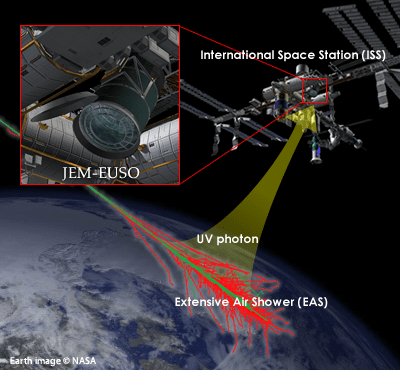A plan to use high-powered lasers to clear space debris could be tested on the International Space Station. Proposed by scientists at the RIKEN research institute near Tokyo, the plan would use a space telescope designed to study the effects of cosmic rays to spot debris, which would then be nudged out of orbit by an optical-fibre based laser.
The RIKEN team, led by Toshizaku Ebisuzki, has published its proposal in the journal Acta Astronautica. They suggest repurposing a telescope with a super-wide field of view, which is being developed at RIKEN as part of a project called Extreme Universe Space Observatory (EUSO) and is set to be mounted on the Japanese Experiment Module of the ISS. EUSO will scan a wide area of the Earth’s atmosphere looking for flashes of light that indicate the impact of a cosmic ray. We realised that we could put it to another use,” Ebisuzaki explained. “During twilight, thanks to EUSO’s wide field of view and powerful optics, we could adapt it to the new mission of detecting high-velocity debris in orbit near the ISS.”

The team plans to combine this extra functionality of EUSO with an optical fibre laser, developed to power particle accelerators. Known as CAN (coherent amplification network) lasers, these produce ultrafast pulses of laser energy while using relatively small amounts of energy by directing the pulse along a bundle of optical fibres. The idea is that these pulses would be directed at pieces of space debris of the size which causes the most trouble for orbital infrastructure: about a centimetre across. The laser would vaporise a portion of the debris, and the Newtonian reaction force of this ablation would slow the debris down, forcing its orbit to decay so that it fell harmlessly into the atmosphere where it would burn up long before reaching the ground. ““Our proposal is radically different from the more conventional approach that is ground based, and we believe it is a more manageable approach that will be accurate, fast, and cheap,’ said Ebisuzkai.
The RIKEN team is proposing a test of the technique by mounting a small version of the EUSO telescope on the ISS, 20cm across, accompanied by a 100-fibre CAN laser. ““If that goes well,” said Ebisuzaki, “we plan to install a full-scale version on the ISS, incorporating a three-meter telescope and a laser with 10,000 fibers, giving it the ability to deorbit debris with a range of approximately 100 kilometers.” The ultimate goal would be to mount thesystem on a free-flying platform that would be placed in a lunar orbit some 800km above the Earth, where the greatest concentration of centimetre-scale debris is found. “We may finally have a way to stop the headache of rapidly growing space debris that endangers space activities,” Ebisuzaki claimed. “We believe that this dedicated system could remove most of the centimetre-sized debris within five years of operation.”




Glasgow trial explores AR cues for autonomous road safety
They've ploughed into a few vulnerable road users in the past. Making that less likely will make it spectacularly easy to stop the traffic for...